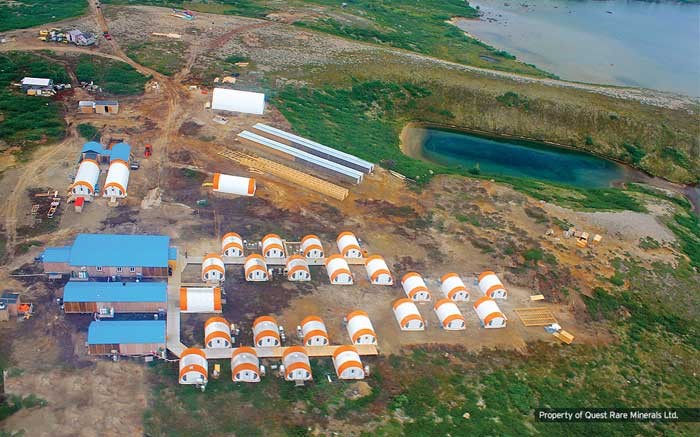VANCOUVER — Canada’s federal House of Commons Standing Committee on Natural Resources has wrapped up a seven-month study on Canada’s rare earth elements (REE) potential, drawing on extensive consultation with a who’s who of Canada’s fledgling REE subsector. The resulting report outlines the state of global REE markets, and explores the challenges associated with realizing a “strategic opportunity” for Canada.
According to the report, global REE production totals 130,000 tonnes per year, which provides an estimated revenue of US$4 billion annually. Though REE production is small compared to other metals, the committee noted that rare-earth metals support a manufacturing sector worth between US$2 trillion and US$4.8 trillion.
Director General of industry and economic analysis of the Department of Natural Resources Christiane Villemure commented that “over the last ten to fifteen years, the world consumption of rare earth elements has increased at 8–12% per annum, a trend that experts agree will continue, and may increase.”
In addition, supply challenges are reportedly anticipated due to absence of efficient recycling programs, with industrial demand for certain REE metals projected to shoot up by as much as 2,600% by 2025, according to studies from the Massachusetts Institute of Technology.
The elements neodymium, europium, terbium, dysprosium and yttrium are highlighted in the report due to their “scarcity, high demand and criticality in much high-tech application.”
The report also notes that the U.S. Department of Energy, Japan and the European community have all defined REEs as strategically “critical.”
Governments have shown some concern over the global reliance on China for REE supply. The country accounts for more than 95% of global REE production.
André Gauthier, president and CEO of Matamec Explorations (TSXV: MAT; US-OTC: MHREF), observed that “not only is China the leader in production, it is also unequivocally the leading expert in downstream processing, [including] all economic spinoffs from secondary processing.”
Luisa Moreno, senior research analyst at Euro Pacific Canada, added that while China supplies almost all of the world’s heavy rare earths demand, its resources are diminishing, with less than 30 years of estimated supply left.
Moreno calculated that US$3 billion had been invested in major REE projects outside of China between 2008 and 2010, with 28 projects qualifying as “advanced exploration” assets, and another 28 projects in earlier exploration stages. Out of those 56 projects, 19 are in Canada, nine in Australia and five in the U.S.
The committee estimates that total capital expenditures needed to develop rare earth mines in Canada range from US$106 million to US$2.5 billion.
The report tallied five projects in Canada that could conceivably reach production within the next five years, including: Avalon Rare Metals’ (TSX: AVL; NYSE-MKT: AVL) Nechalacho project in the Northwest Territories; Quest Rare Minerals (TSX: QRM; NYSE-MKT: QRM) Strange Lake project in Quebec; Matamec’s Zeus–Kipawa joint venture in Quebec; Pele Mountain Resources’ (TSXV: GEM; US-OTC: GOLDF) Eco Ridge project in Ontario; and Orbite Aluminae’s (TSX: ORT; US-OTC: EORBF) Grande-Vallée property in Quebec.
The committee could not estimate the total economic value of Canada’s REE deposits, but noted that according to a report published by Washington, D.C.-based Rare Earth Technology Alliance the industry contributes to the North American economy, with $795 million in shipments employing nearly 1,050 workers with a payroll of $116 million. Moreno added that REE estimates suggest that “hundreds of thousands of jobs can be created across various industries that use rare earth metals.”
The report emphasized that Canada is in a “race” with Australia and the U.S. to meet demand for diversified REE production. The committee warned that Canada’s $1-million REE research and development investment over the past three years is “relatively small” compared to other nations. The U.S. has invested $120 million in research over the past five years, while Australia has spent $80 million over the last three years.
Industry participants in the committee’s work included executives of a number of REE juniors who pushed for more financial help from the federal government and a stronger public endorsement of the Canadian REE industry.
Avalon’s vice-president of sales and marketing Pierre Neatby said this kind of support “could go a long way to inspiring confidence in the capital markets. Ideally, this would start with a short report from the committee on what has been heard, along with some recommendations, and accompanied by a public statement by the government to let the world know that Canada is serious about being a player in this industry.”


Canada should help propspectors too.
I hold a REE propperty where 143 carbonatite and related lithological showings have been recognized to date within the Grevet REE Property. At least 50 of these showings have produced rock samples with elevated REE > 0.50% total rare earth oxide, (TREO) in carbonatite, with 14 showings having greater than 1.0% TREO, and 3 showings having rock samples with 12.24%, 19.6% and 20.4% TREO.
REE Property composed of 20 MDC (Map Designated Claim) covering 905,46 Ha (as of June 16 2014) and is ready for first phase drilling.
Need investors.
as a company u mst work harder nt to loss agai